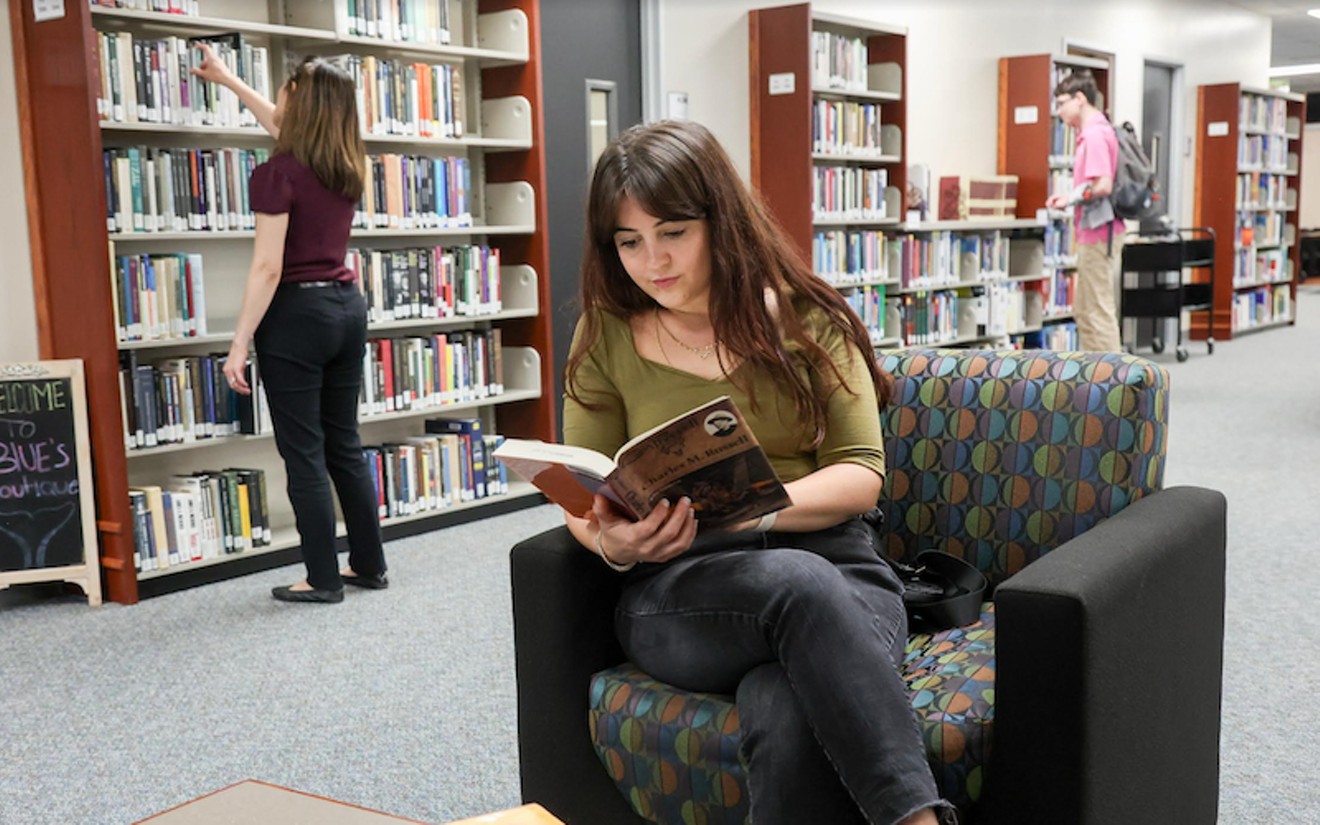“I was thinking this was my time to be independent, be on my own, finally get a vehicle and an apartment,” she said. “But then, once I started thinking about it, I realized it’s not easy.”
Although Sanchez considered leaving her hometown, it was all she knew. Once she decided to stay locally, she weighed her options and factored in what her family could afford. Neither her father nor mother had higher education degrees; however, she grew up watching her sisters attend Alvin Community College.
After looking into the school, she got involved in its high school student program, and saw that her family could financially swing it and enrolled.
“People were working to help me, especially with the affordability,” she said. “I know some people might feel different, but I knew that was where I could get help in ways that – at a university – I might not have.”
More students may opt to take the route that Sanchez did as the cost of higher education at public and private four-year institutions continues to increase, making it exceedingly inaccessible for more and more students to attend these colleges and universities.
Many of the ones that go to these schools rely on federal financial aid, scholarships, grants and loans to try and make their way through graduation – yet are still drowning in expenses.
Is student loan debt worth it?
It hasn't helped any that the U.S. Supreme Court said no to the Biden administration's student loan forgiveness program that would have wiped out $10,000 to $20,000 in debt for qualifying students.Shar-day Campbell, the strategic enrollment communications manager at Houston Community College, said not only has this forced some who took out student loans to adjust their budgets. It has left those thinking about pursuing a degree in a bind.
“Now that the court has decided, students are at a crossroads. They are questioning whether to continue to go to school and incur debt or if they should cut their losses,” she said. “You’ve got this idea of debt looming over you, and people start thinking about their options. I think that will be a sweet spot for community colleges.”
Community colleges have long been considered an affordable route to an associate degree or a stepping stone toward a bachelor’s degree at a fraction of the cost when compared to a four-year institution.
According to the education data initiative, a website that features information about higher education, the average cost of in-state tuition at a Texas community college is $2,280, while out-of-state tuition is $6,610. Meanwhile, attending a Texas public university – cheaper than a private school – can cost a little over $10,000 after fees. This number could climb to more than $22,000 with room and board included.
But the knock on community colleges is two-fold. Their graduation rates, although improved in recent years, are still very low. HCC’s six-year-graduation rate is 42.8 percent, San Jacinto College’s four-year is 31.9 percent, and Alvin’s is 29 percent.
Also, many students have complained that the community college courses they take don't always transfer to four-year schools — a waste of their time and money. In recent years there have been more agreements reached between in and out—of-state universities and community colleges to better ensure that the transfer process goes more smoothly. For instance, HCC has what's known as "articulation agreements" with more than 55 universities to keep its students on track to easily move to a higher level university.
Upping their game in terms of assistance from academic and financial advisers and guidance programs, helps these community colleges keep students from dropping out.
Catering to Their Demographics
Students entering higher education later in life may also want to take advantage of starting schooling at a lower cost.Amanda Smithson, the Director of Recruitment and Enrollment at Alvin Community College, said financial aid covers more expenses at most community colleges compared to four-year colleges or universities.
“Grants like these go a lot further with us,” she said. “Here, about $4,500 will likely cover your tuition, books and fees, whereas at a university, that might pay for two or three classes.”
India Granger, a 21-year-old Houston Community College student, graduated from HCC in 2022 with her applied science associate degree in music business. However, after recently getting into the University of Houston and researching, she realized she had not completed many required introductory courses.
To save money, Granger started classes back up at HCC this past spring, as she had to take out loans atop the financial aid, grants and scholarships she received – and wanted to do anything she could to avoid accruing even more debt.
“I wanted to complete as many of these courses as possible before going into a higher price bracket,” she said. “I felt like taking them there would make more sense financially.”
Middle-aged or older community college students may be looking to transition careers to make more money – but have impending financial responsibilities or other priorities that make these schools a better fit for them.
Catherine Green, a 44-year-old student at San Jacinto College, had been away from the classroom for almost two decades when she decided she wanted to return to get her associate degree.
She initially wanted to attend Texas Southern University but thought she might be overwhelmed at a full four-year institution.
“I felt like finding peers would’ve been similar to finding a needle in a haystack there, but at San Jac, the kids are after the same thing I was after,” Green said. “They might not have seen themselves starting at a full university. They might have seen themselves going into trade, becoming an HVAC technician, going into cosmetology or waiting to transfer after getting their associate degree.”
Green also went for the affordability aspect, as she has financial aid covering all her tuition costs. She knows firsthand how expensive college can be. Not only was she originally enrolled at a two-year institution attempting to make her pay $50,000 (which she got herself out of), she has a daughter who graduated from university and is now pursuing a master’s – but is in $150,000 of student loan debt.
“I think once more students run from universities, a light bulb will go off,” she said. “We’re not asking for free education. We’re just asking for something that we can afford. Because so many people out here want to continue their education.”
Battling Narratives
Campbell said these local schools may provide an economically feasible and more suitable alternative to higher education, but they still face roadblocks as organizations.“All community colleges nationwide are battling narratives,” she said. “In a sense, you could say we are battling two narratives; that community colleges are not college and college is too expensive, so students feel like they don’t belong.”
Campbell said both of these common misconceptions are rooted in a need to understand what students can expect to experience.
“The average age of our students is 24 years old, that means that person is doing life, and sometimes life will life,” Campbell said. “They have bills, maybe dependents and responsibilities, so we’re thinking about how to make sure they have access to what they need.”

Many community colleges offer either peer or staff mentors to work with and keep students engaged and on track.
Photo by Alvin Community College
Marittzza Blanco, a 21-year-old San Jacinto College student, was drawn into attending school because of this additional support. She got trapped in thinking that higher education was not for her – even though she wanted to pursue it – because she had a son. Then the pandemic sent her life into a tailspin.
“Of course, I had dreams of attending Baylor, Rice or the University of Houston, but life got real for me,” Blanco said. “I don’t think that if I went to any of those schools, I would have been as lucky or tended to.”
The selling point for Blanco was that San Jacinto offered childcare to full-time students. Once she learned about this, she filled out the necessary paperwork, got approved and began attending classes.
Blanco is now working toward her associate degree in business administration. She said her professors are incredibly understanding and willing to work with her when she may have to skip class if emergencie arise.
Weighing the costs
Despite these schools working hard to find all the financial support and outside resources these students might need, students at community colleges still rely on financial aid to get them through to their graduation date.Granger, a borrower herself, said she pushed through to get her associate degree first before transferring to have a mechanism that would make it easier for her to find work so she could pay off her debt accumulated while at HCC. Her repayment plan starts in the fall, and she plans to make payments before getting her bachelor’s.
“There is this kind of pressure that hangs over me to figure something out so I can do what I need to do to make those payments,” she said. “The issue isn’t school or being involved in classes. Students will show up, sign up, enroll and they will pass. It’s the issues that come after we leave.”
According to Smithson, two of the largest sources of funding for Alvin Community College students come from Pell grants – grants given to students from lower-income households – and student loans, despite the cheaper tuition and overall costs.
Sanchez is a Pell grant recipient, so she can luckily dodge debt as this grant covers almost all of her tuition not covered by the other scholarship, she has through the college directly.
She plans to transfer to the University of Houston Clear-Lake after finishing her associate’s degree in business administration. She later wants to own her own business — either a panaderia (Mexican pastry shop), hair salon or a mix of both.
“Now that I am here, I am really glad that I am,” Sanchez said. “I have friends who tell me they wish they went to community college instead of rushing into university because now they have debt. It’s difficult, especially when you’re new to this world and don’t know what to expect.”







